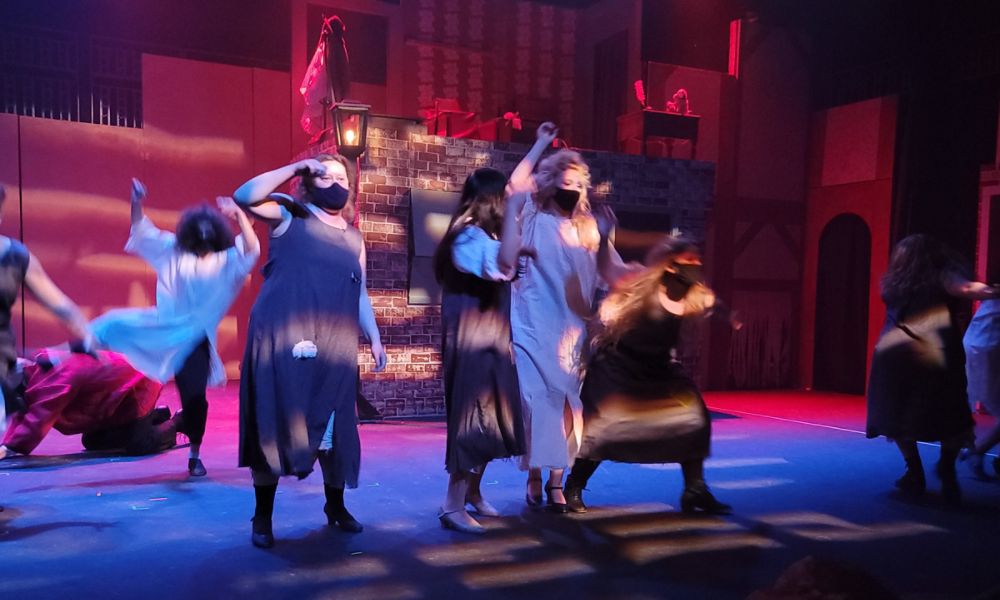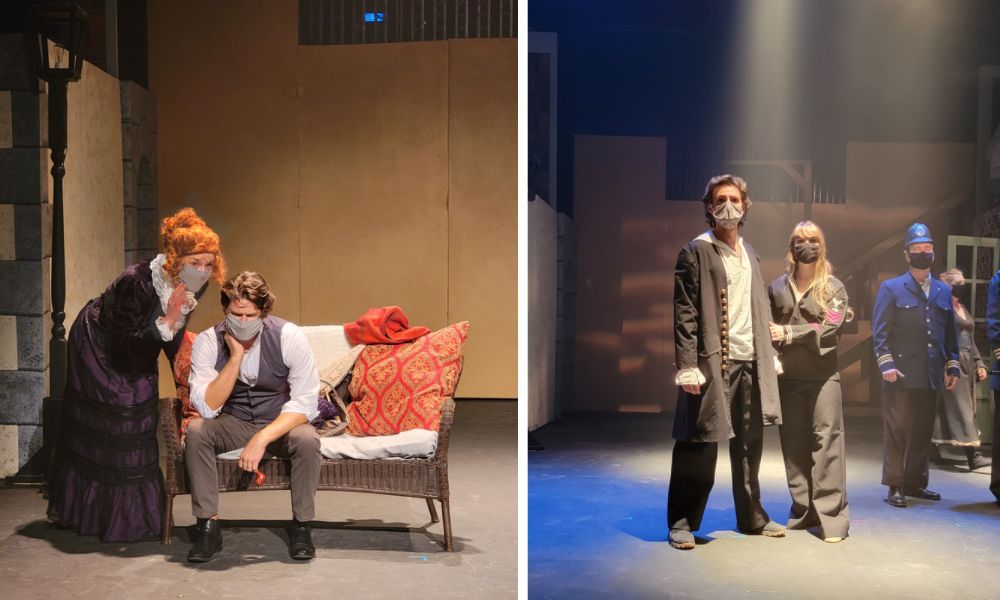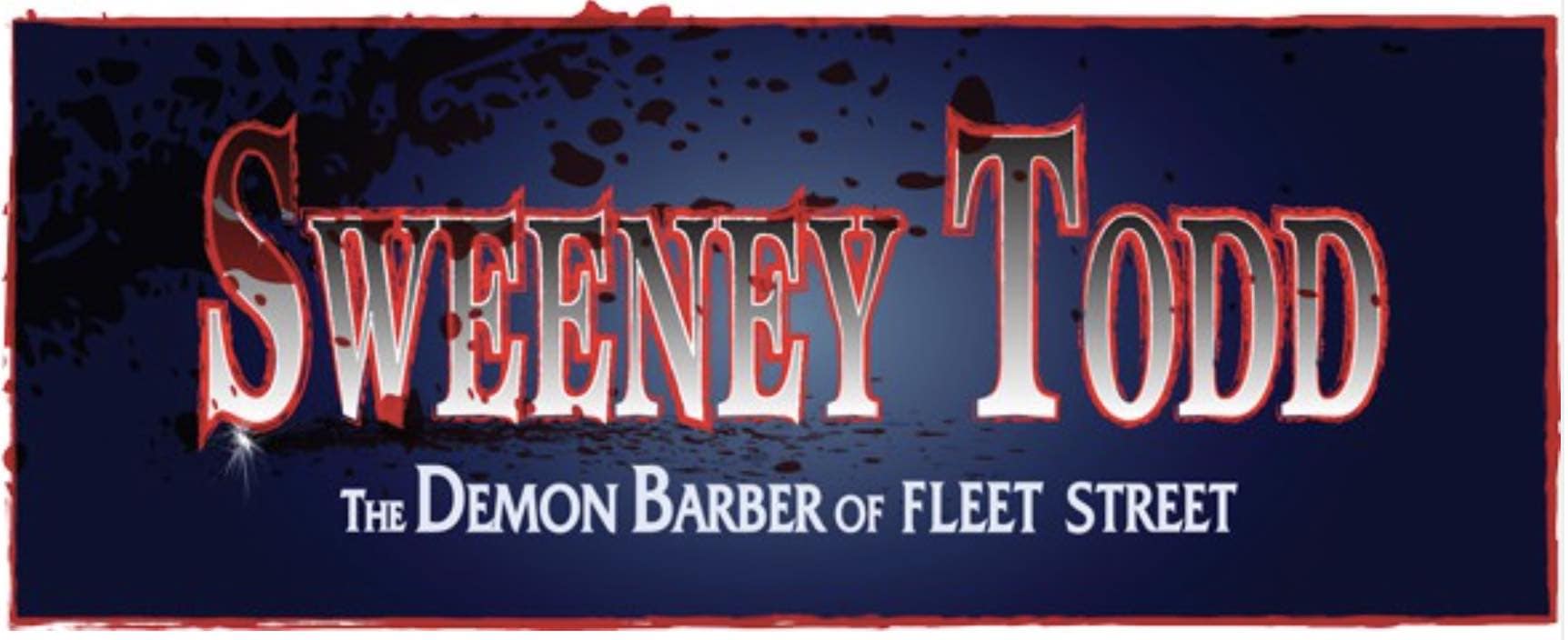A good man, foully wronged, seeks revenge against the perpetrator. Thwarted, he enlists on the side of death and chaos, ultimately losing everything. Such is the central tragedy of Stephen Sondheim’s “dark operetta” Sweeney Todd, a secular parable of damnation.
The show depends on strong singer/actors portraying the powerful, if disordered, emotions of its characters. In this and other respects, Rooftop Productions’ current presentation of the show is a mixed bag.

In the production’s most complete performance, Jay Tilley succeeds in putting across both the self-righteous evil of Judge Turpin and the weight of the guilt he carries, the latter expressed in the frightening “Johanna,” in which the Judge flagellates himself as he lusts for his teenage ward.
Shelby Young has the perfect soprano voice for Johanna. Her “Green Finch and Linnet Bird” is lovely, and she fortunately plays the character as less ditzy than many actors have done. As her lover, Anthony Hope, Matthew August brings a pleasant baritone sound to his rather earnest character. The two capably manage the difficult timing of “Kiss Me.” The most operatic role in the show belongs to the Beggar Woman, and Sara Watson had the vocal chops to take advantage.
Jason Curtis is easily the most understated Sweeney I have ever seen, quiet and low-key in many of his spoken and singing lines. In the pivotal “Epiphany,” Sweeney declares that he is “full of joy.” That dreadful joy, as well as the manic hilarity of the great list song “A Little Priest” that follows, have greater impact if a Sweeney is able to portray more of the intense and ever-darkening life force that has sustained him through injustice, exile, a perilous escape, and planning for vengeance. Curtis does, however, hit just the right tone for the final scene, when Sweeney realizes what he has done.
Mrs. Lovett (Jennifer Pagnard) is, in Sondheim’s view, the real villain of the show. The original Mrs. Lovett, Angela Lansbury, called the character’s personality “dotty music hall,” and Pagnard runs with that concept. Beneath the silliness, Pagnard conveys Lovett’s amoral rationality that leads to so much destruction. Pagnard’s singing is most effective in legato numbers like “Wait.”

Sondheim’s music is extraordinarily challenging to sing, and some of the supporting actors were not fully up to its demands.
Sweeney Todd is a strong ensemble show, and Rooftop’s ensemble did its varied job well. The group gave a rousing rendition of “God, That’s Good,” the Act 2 opener praising Mrs. Lovett’s new, improved meat pies. “City on Fire” strikingly conveys the hellscape of industrial revolution era, Dickensian London, and the madness of life there. The production’s use of smoke effects throughout added to the stygian atmosphere. Placing ensemble members on the theater’s side walkways in some numbers was effective.
Sweeney Todd is not, however, a dance show, and choreographer Gretchen West Lamb’s attempts to add dance elements to the opening and closing “Ballad of Sweeney Todd” numbers misfired. “Attend the tale of Sweeney Todd” — the show’s first and, for Sondheim, most important line — sets up telling and concluding the story, and having the ensemble march about while making large gestures diverts the audience’s attention from the storytelling. The frenetic craziness of the movement in “City on Fire” works better, however, given that the ensemble has just escaped from Fogg’s Asylum.
Vincent Worthington’s direction allows the pace of the 90-minute Act 1 to lag. Actors too frequently engage in overbroad gestures, which could profitably have been moderated. There were also unforced errors. For example, what appeared to be the shade of Lucy (Sweeney’s lost wife) made an appearance in the barbershop during the well-sung “Pretty Women” duet between Sweeney and Turpin. The score makes perfectly clear who the characters are imagining, making this note of literalism superfluous. Placing Johanna adjacent to Judge Turpin during his “Johanna,” flinching with his every whip stroke, or having an ensemble member draw focus from Pirelli’s number by sneaking into the pie shop to bag a stuffed cat, are equally unnecessary and distracting. One seldom goes wrong trusting Sondheim’s material while avoiding extraneous additions.

Consistent with Hylton Performing Arts Center policy, cast members as well as the audience wore masks during the show. While a commendable health precaution, this comes with costs. Cast members had to mime eating, drinking, shaving, and kissing. Neither cast members nor the audience could see actors’ facial reactions. Most important, the muffling effect of the masks left a great many lines extremely difficult to understand, a real issue given the rapid-fire verbal pyrotechnics in Sondheim’s work.
The production used dinner theater–style recorded orchestral accompaniment, which posed the typical timing issues for actors. The set design (Ted Ballard) eschewed the usual rotating central unit in favor of two-story structures on stage left and right, representing respectively the pie shop/barbershop and Judge Turpin’s house. (Johanna’s room, far from being “damask and dark” as her song says, featured bright pink and white striped wallpaper.) The body-conveying chute to the bakehouse worked well. Hair design (Larissa Norris) had some oddities: Sweeney’s hair looked every bit as youthfully full as Anthony’s, not a bit of gray in sight. Johanna’s hair was brownish, notwithstanding a second-act song describing its specific tone of yellow. The lighting design (Ken and Patti Crowley) made good use of specials, though apparent operational problems left characters in the dark on a few occasions.
Sweeney Todd is one of the greatest shows in the Broadway canon, and mixed results or not, engaging with its glories and complexities is a worthwhile endeavor for both participants and audiences.
Running Time: Two hours 55 minutes, with one intermission.
Sweeney Todd presented by Rooftop Productions is playing through October 31, 2021, at the Hylton Performing Arts Center’s Gregory Theatre, 10960 George Mason Circle, Manassas, VA. Tickets ($25) are available online.
Hylton Performing Arts COVID Policy
Beginning October 18, 2021, all attendees regardless of age who attend an indoor event or performance at the Hylton Performing Arts Center, must be fully vaccinated against Covid-19 by the date of their visit and present proof vaccination OR show a negative COVID-19 test result upon entry. Acceptable negative results must be from CDC approved Rapid Antigen tests within 48 hours of performance time or PCR tests within 72 hours of performance time. The Hylton Performing Arts COVID vaccination policy is here. Face coverings are required indoors for patrons ages two and up.





